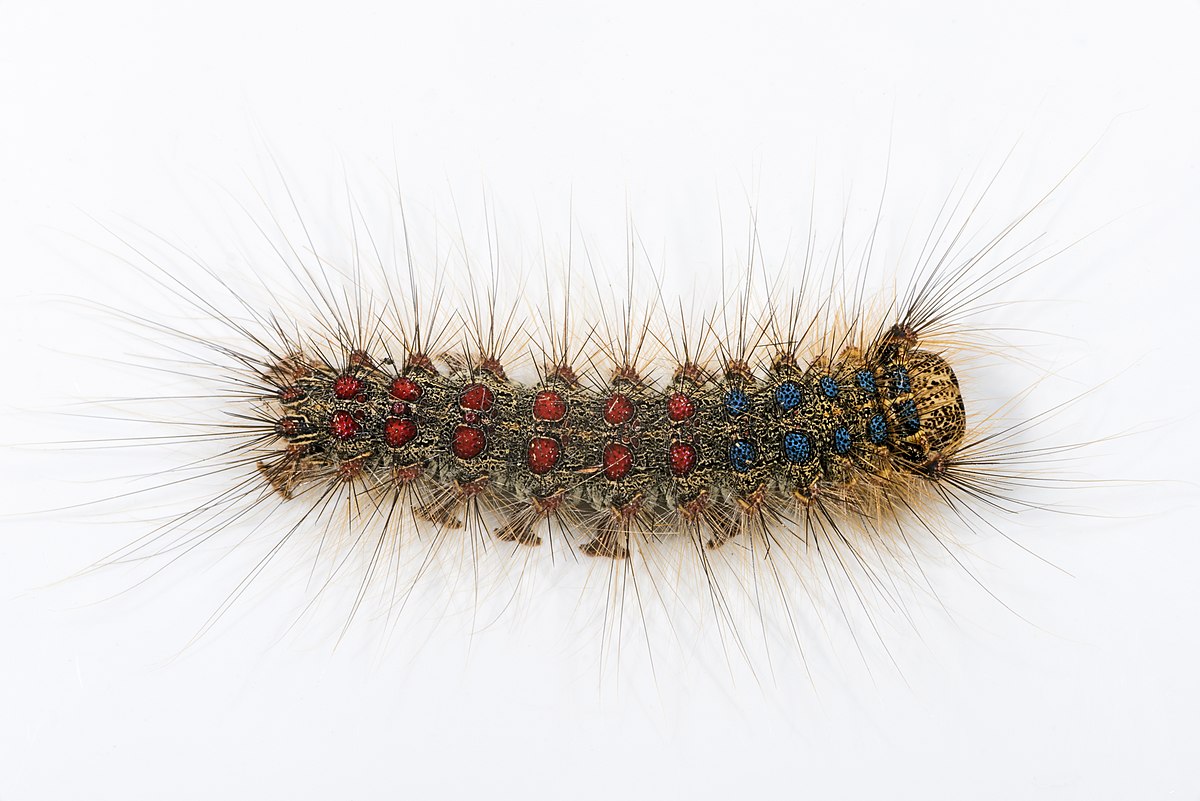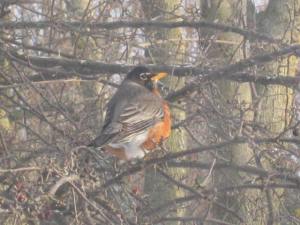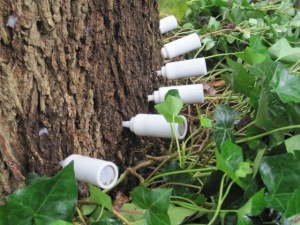An Unwelcome Traveller
Travelling is an enjoyable pastime. You get to see new places, meet new people and eat new things. That is one of the reasons why gypsy moths got their name; they do all of those things. They easily attach onto objects, like tents, vehicles, firewood, lawn chairs and more, or quite happily blow in the wind to move from place to place to find their next meal.

Gypsy Moth caterpillar – “Lymantria dispar MHNT Chenille” by Didier Descouens – Own work. Licensed under CC BY-SA 4.0 via Commons.
The problem is that gypsy moths are not native to North America and their travels here have left a swathe of destruction in their wake. They are indiscriminate in their taste for leaves, preferring deciduous trees, but have been known to strip a coniferous tree or two as well. While deciduous trees can survive a defoliation, albeit in a weakened state, coniferous trees are less resilient and may die after a first attack.
So how did this invasive species arrive in North America in the first place? A good idea gone awry again. Back in 1869, a French naturalist thought it would be a good idea to cross European gypsy moths with North American silkworms to create a silk industry in North America. Sounds like a good idea, right? Wrong! Some gypsy moths escaped and have been spreading across North America since then. In Canada, they are found in Ontario, Quebec, and across the Maritime provinces.
While some pests are exclusive to a certain type of tree, gypsy moths earn their title as one of North America’s worst invasive insects due to their wide tastes. Gypsy moth caterpillars have been known to eat oak, aspen, birch, basswood, hawthorn, willow; pretty much any tree they come across.
It is when gypsy moths are in the caterpillar or larva stage that they are the most destructive. They eat any leaves they come across and will climb anything to get to them. Larvae go through five instars or molts. They grow larger after each successive instar, starting at 3 mm and growing to 50-90 mm in size before they reach the pupae stage. During the pupal stage, they change from caterpillars to adult moths. Moths then mate, lay eggs and die within a week. Male gypsy moths often mate with several females, although the larger females usually only mate once before laying upwards of 500 eggs. This is the stage where the gypsy moth overwinters, reducing water content, so as to withstand freezing temperatures. Come spring, the eggs hatch and the cycle begins all over again.
There are ways to control gypsy moth outbreaks. Egg masses can be removed and burned or soaked in a soap/bleach and water bath. Caterpillars can be hand-picked and crushed (wear protective gloves as they cause allergic reactions or skin irritation for some). You can also set up traps using a wide burlap band wrapped around a tree. Caterpillars hide in the burlap during the heat of the day and can easily be removed. TreeAzin is also registered for use against gypsy moths and CLC Tree Services is a licensed pesticide administrator, for those facing larger infestations.
Of course you could go the route of introducing predators to control gypsy moths when you come across them in your trees. The white-footed mouse, short-tail shrew and small wasps all have an appetite for gypsy moth caterpillars. Or you could fill up your bird feeders and hope the local birds pick off the fuzzy intruders in your yard. Bluejays, robins, northern orioles and chickadees all enjoy gypsy moth larvae and pupae. And I don’t know about you, but I would far rather watch the birds perch in the healthy trees in my yard (and nibble invasive gypsy moths), than to have to go caterpillar stomping. Wouldn’t you?

Many birds, like this robin, help control gypsy moth populations, so encourage their presence in your yard





Destructive but so beautiful! Looks like this caterpillar has jewels embedded along its back.
Hope the birds eat all of these tasty treats!
They are easy on the eyes, but we’d rather you leave them to the birds to appreciate Mary.
Thanks for your comment.
I don’t think I have ever seen a gypsy moth caterpillar in my yard. However, every year I have to have “tents” cut off of my trees because of the dreaded tent caterpillars. It is amazing how many caterpillars are jammed into just one of those tents. And once they break out and start to travel around, they are extremely destructive–much like your description of the gypsy moth caterpillar.
I took a photo of one of their tents back in July, right before I sprayed it and cut it down (Luckily it was within my reach). I tried to make the photo a little prettier by applying the Photoshop “Oil Paint” filter, but in actuality–there is nothing pretty about a creepy, crawly tent like this! It is the 4th photo: http://storieswithnobooks.com/2015/07/26/thought-dreams-nature/
You made it much prettier! We had a post about tent caterpillars earlier this summer as well. https://clctreeservices.wordpress.com/2015/07/15/pitching-a-tent/
I just looked at your article. Eeek! Every time I see them, I shudder. Those tent caterpillars cause so much trouble every year!
That they do. At least if you keep on top of them you won’t necessarily lose your tree, unlike with other pests that attack trees (culprit #1 EAB).